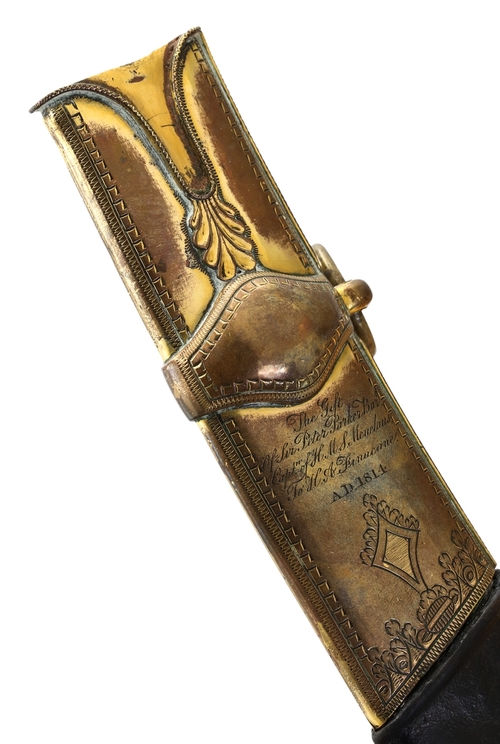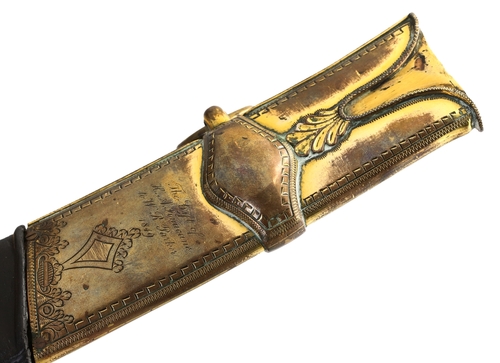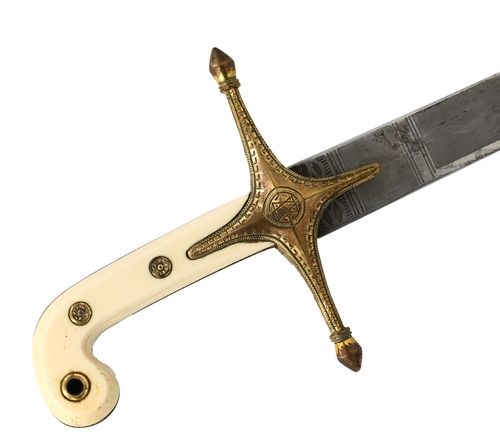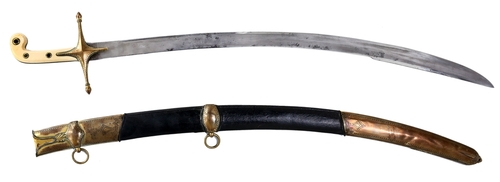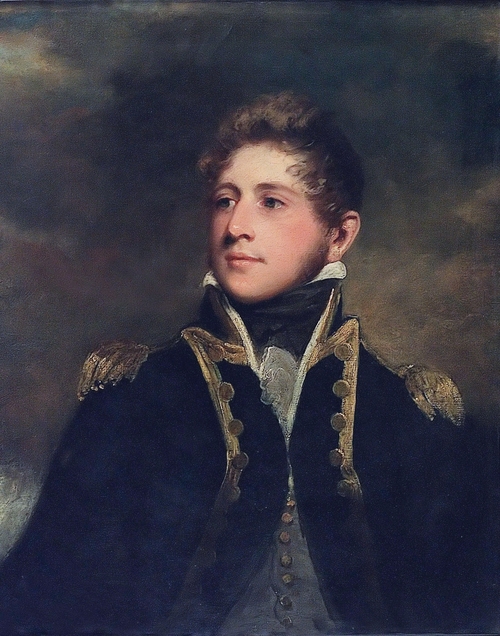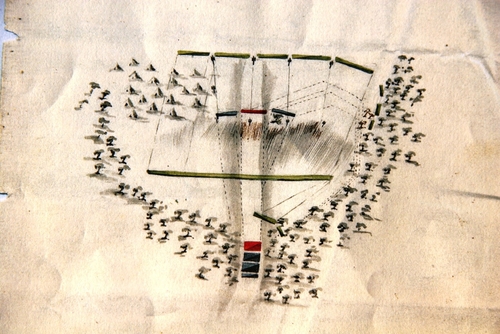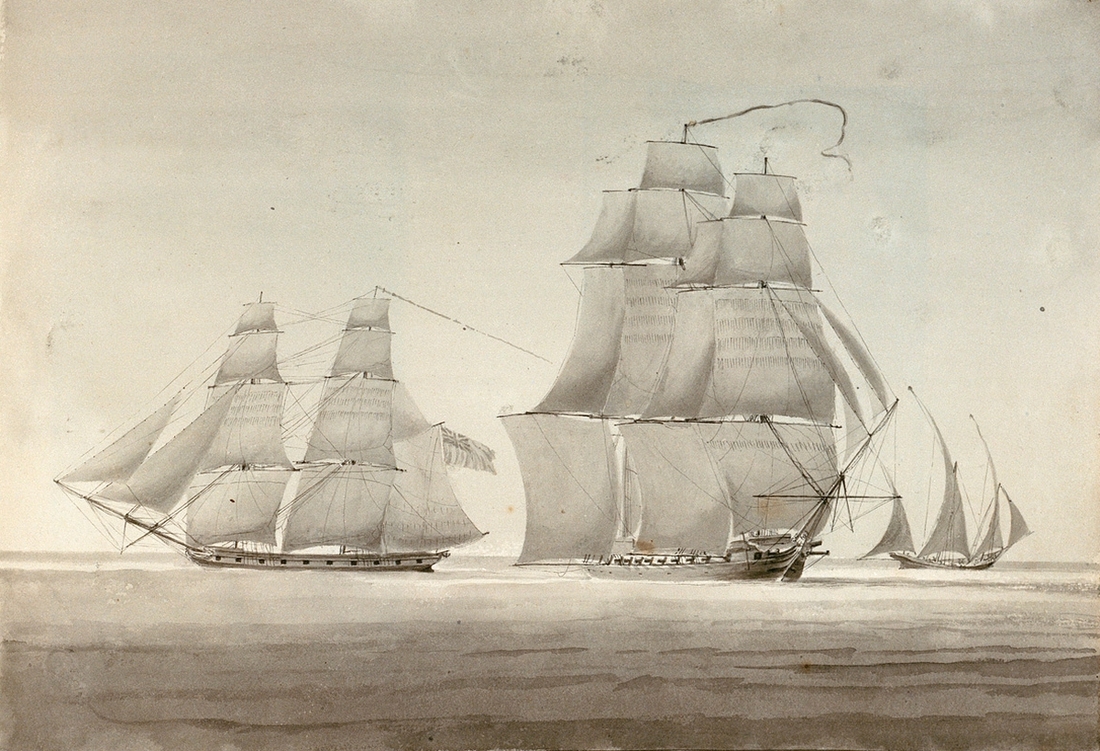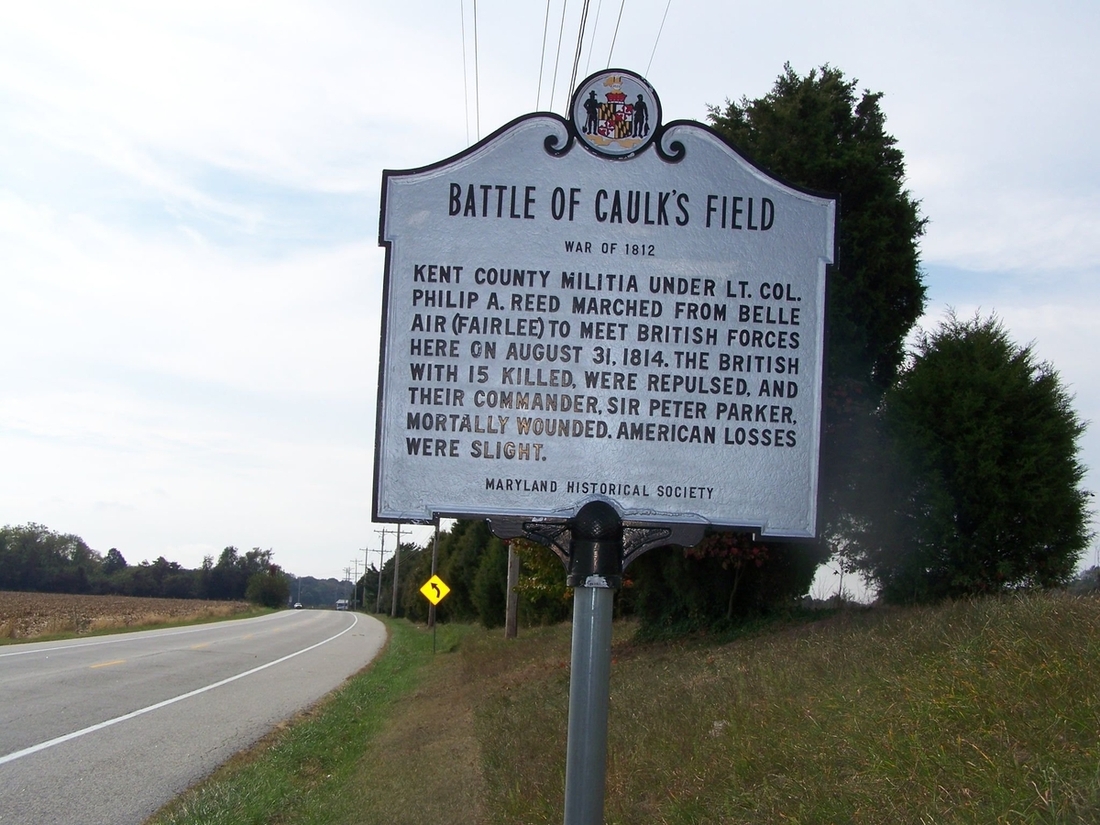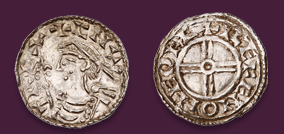Auction: 25003 - Orders, Decorations and Medals
Lot: 99
(x) The fascinating Royal Navy 'War of 1812' Mameluke-style sword given to Midshipman H.A. Finucane by Captain Sir Peter Parker Bt.: shipmates aboard the frigate H.M.S. Menelaus, both men were to participate in raids ashore along the eastern coast of the United States until the Battle of Caulk's Field where, on 31 August 1814 and by the light of a full moon, Parker met his untimely end, being mortally wounded by an American musket ball
'Mameluke'-style sword, of early 19th manufacture, a lightly curved flat, plain blade with pronounced false edge, engraved gilt-brass cross-guard and langet, grip of bone or ivorine, leather scabbard with gilt brass locket, chape and suspension rings, these all extensively engraved and decorated, the locket attractively engraved to both sides: The Gift Of Sir Peter Parker Bart, Captn. of H.M.S. Menelaus, to H.A. Finucane. A.D. 1814 and: The Gift of H.A. Finucane to W.R. Parker 1849, the chape attractively engraved: Capt. V.E.C. Parker 1876 and Capt. V.E.H.R. Parker 1914., overall length 935mm, leather part of scabbard sometime replaced with sword not fully fitting, nevertheless good very fine and an important, positively-attributed piece of Napoleonic Naval history
Henry Augustus Finucane was born in 1798 and entered the Royal Navy on 2 August 1811 as a Volunteer Second Class. Immediately posted to the 36-gun frigate H.M.S. Owen Glendower, he shortly removed to the 38-gun frigate H.M.S. Menelaus, aboard which vessel he was to serve almost the entirety of the Napoleonic Wars. A new ship launched in 1810, Menelaus was commanded by Captain Sir Peter Parker Bt., scion of a distinguished Naval family and known to be a dashing and enterprising officer. Assignment to a frigate meant much more chance of action than aboard a ship-of-the-line and Finucane must have felt fortunate to have been assigned to such a crack ship with a famous captain.
The year 1812 found Menelaus in the Mediterranean, nominally part of the blockade off Toulon but also operating extensively against harbours, shipping and privateers off the southern coast of France - indeed, Finucane is noted as (presumably) having some detached role or position of responsibility on 29 May that year when he was subject to 'a fire from the batteries on Pointe Ecampebarion, during an attempt...to cut off a French frigate and brig from entering Toulon.' (A Naval Biographical Dictionary - Finucane, Henry Augustus, W.R. O'Byrne, refers). In 1813 Parker's command was reassigned to the Atlantic for convoy protection and shortly afterwards became heavily involved in the War of 1812, operating off the coast of Maryland to disrupt American coastal traffic and generally make a nuisance of himself in the eyes of the enemy. During the Chesapeake Campaign, Menelaus 'was sent up the Chesapeake to divert the attention of the enemy in that quarter' (London Gazette, 27 September 1814, p. 1939 refers) and, as Midshipman Frederick Chamier (one of Finucane's comrades in the Midshipman's Berth) later wrote: 'Our duty consisted in an eternal annoyance of the enemy, and therefore night and day we were employed in offensive operations'. Parker and his men were extremely active in making landings ashore, destroying American farms and as much property as possible along the river - undoubtedly young Midshipman Finucane must have been one of their number and perhaps it was for one of these small actions, now lost to history, that Parker presented Finucane with this sword. However, American forces were about to extract their revenge on the British captain and his men.
Late on the night of 30 August 1814, Parker, Finucane, and sailors and Royal Marines from Menelaus landed at Tolchester, Maryland, and advanced inland to attack a detachment of the 21st Maryland Militia stationed nearby. William James, in his 'Naval History of Great Britain' (1837), takes up the story: 'We formerly noticed that Sir Peter Parker, of the Menelaus frigate, had been detached on service up the Chesapeake Bay. Having but recently arrived on the North American station, Sir Peter was not aware of the ambushing tricks to which to which a small invading force would be exposed, in a country so filled with woods, ravines, and defiles; and where local knowledge, and skill with the rifle, were an overmatch for all the valour he could bring against them. Information having reached the ship, then at anchor off Moor's fields, that 200 American militia were encamped behind a wood distant about a mile from the beach, Captain Parker, at 11 p.m. on the 30th of August, was induced to land with 104 seamen, and 30 marines, in two divisions, one commanded by Lieutenant Henry Crease, with Midshipman Henry Finucane, the other by Lieutenant Robert Pearce, and Midshipman Frederick Chamier.
It appears that Colonel Read, the commander of the American force, stated that 170 Maryland volunteers, having been apprized of the intended attack, had retired to a small open space, surrounded by woods, distant four or five miles from his first encampment. Thither, having alarmed a small cavalry picket, the heedless seamen and marines, headed by their undaunted chief, proceeded. The enemy, with some pieces of artillery, was found drawn up in line in front of his camp. The British commenced the fire; and, charging, drove the Americans through their camp into the woods. It was about this time that Sir Peter received a mortal wound from a buck-shot, which divided the femoral artery, and which occasioned his bleeding to death before medical assistance could be procured. Secure behind the trees, the Americans levelled their pieces with unerring aim; while the British, deceived by the apparent flight of their wary foe, rushed on through the woods, until, bewildered and embarrassed, the survivors of this adventurous band were compelled to retreat to their ship; bringing away, however, the body of their lamented commander, and all their wounded but three. The British suffered a loss of 14 killed, including Sir Peter Parker and Midshipman John T. Sandes, and 27 wounded, including both lieutenants of marines, Benjamin George Benyon and George Poe.' By this action (known today as the Battle of Caulk's Field), the Royal Navy lost an able leader and Midshipman Finucane an excellent Commanding Officer.
Menelaus (now under the command of Captain Richard Dix) was present, two weeks later, at the Battle of Baltimore and later returned to Europe for the last throes of the Napoleonic Wars, participating in the capture of several French coastal vessels off the coast of Brittany on 19 July 1815. Finucane appears to have remained in the Royal Navy and finally gained his promotion to Lieutenant on 30 November 1820, serving aboard such vessels as the 74-gun Rivoli and the Royal Yacht H.M.Y. Royal George whilst she was commanded by Sir Charles Paget. In 1823 his name appears in the newspapers, where he is referenced as 'a well known dandy', for getting into debt with two tailors - however, the Court observed: ...'that when tailors or other tradesmen came into that Court, to complain of the extravagance of insolvents, they should first show that they themselves were not to blame in encouraging that extravagance, by allowing young men credit to any amount, without at least using a reasonable degree of diligence in inquiring and ascertaining whether or not they had the means of paying them.' (The British Monitor, 28 September 1823, refers). Finucane was consequently discharged with no case to answer! He spent a few brief years in the service of the Coast Guard during the 1840's and appears to have died circa 1850. The names engraved on the scabbard suggest that Finucane returned this sword to the Parker family shortly before he died, and that it was subsequently passed down through the generations until it left their possession in the 20th Century.
Subject to 5% tax on Hammer Price in addition to 20% VAT on Buyer’s Premium.
Estimate
£500 to £700
Starting price
£400


